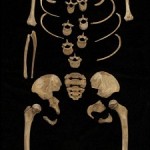 An team of Austrian archaeologists think they may have found the remains of Cleopatra’s younger sister Arsinöe in a tomb in Ephesus, Turkey. Anthony and Cleopatra had Arsinöe was assassinated on the steps of the temple of Diana in Ephesus to eliminate a potential threat to their throne.
An team of Austrian archaeologists think they may have found the remains of Cleopatra’s younger sister Arsinöe in a tomb in Ephesus, Turkey. Anthony and Cleopatra had Arsinöe was assassinated on the steps of the temple of Diana in Ephesus to eliminate a potential threat to their throne.
The tomb in question was discovered in 1926, the skull of its inhabitant removed and measured by the scienticians at the time. It was lost during World War II, though, so all that’s left is the skeleton in the sarcophagus.
In the early 1990s Thür reentered the tomb and found the headless skeleton, which she believed to be of a young woman. Clues, such as the unusual octagonal shape of the tomb, which echoed that of the lighthouse of Alexandria with which Arsinöe was associated, convinced Thür the body was that of Cleopatra’s sister. Her theory was considered credible by many historians, and in an attempt to resolve the issue the Austrian Archeological Institute asked the Medical University of Vienna to appoint a specialist to examine the remains.
Fabian Kanz, an anthropologist, was sceptical when he began this task two years ago. “We tried to exclude her from being Arsinöe,” he said. “We used all the methods we have to find anything that can say, ‘Okay, this can’t be Arsinöe because of this and this’.”
After using carbon dating, which dated the skeleton from 200BC-20BC, Kanz, who had examined more than 500 other skeletons taken from the ruins of Ephesus, found Thür’s theory gained credibility.
 Here’s the thing, though. It’s all really, really tenuous. Facial reconstructions based on 80 year old measurements of a skull that no longer exists, a vague 200 year date range and unusual tomb shape that might or might not refer to a lighthouse that also no longer exists are evidence of pretty much nothing in my book.
Here’s the thing, though. It’s all really, really tenuous. Facial reconstructions based on 80 year old measurements of a skull that no longer exists, a vague 200 year date range and unusual tomb shape that might or might not refer to a lighthouse that also no longer exists are evidence of pretty much nothing in my book.
Add to that the ludicrous “Cleopatra was part African” spin based on the 1920’s measurements that suggest an elongated skull and it really gets goofy.
There’s no evidence that Cleopatra and Arsinöe were full sisters, so even if the ethnicity claims about the skeleton are true and it can somehow be confirmed that the remains are Arsinöe’s — two highly unlikely scenarios — that would say exactly nothing about Cleopatra’s ethnicity.